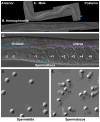EGG molecules couple the oocyte-to-embryo transition with cell cycle progression
- PMID: 21630144
- PMCID: PMC3275084
- DOI: 10.1007/978-3-642-19065-0_7
EGG molecules couple the oocyte-to-embryo transition with cell cycle progression
Abstract
The oocyte-to-embryo transition is a precisely coordinated process in which an oocyte becomes fertilized and transitions to an embryonic program of events. The molecules involved in this process have not been well studied. Recently, a group of interacting molecules in C. elegans have been described as coordinating the oocyte-to-embryo transition with the advancement of the cell cycle. Genes egg-3, egg-4, and egg-5 represent a small class of regulatory molecules known as protein-tyrosine phosphase-like proteins, which can bind phosphorylated substrates and act as scaffolding molecules or inhibitors. These genes are responsible for coupling the movements and activities of regulatory kinase mbk-2 with advancement of the cell cycle during the oocyte-to-embryo transition.
Figures




Similar articles
-
EGG-3 regulates cell-surface and cortex rearrangements during egg activation in Caenorhabditis elegans.Curr Biol. 2007 Sep 18;17(18):1555-60. doi: 10.1016/j.cub.2007.08.011. Curr Biol. 2007. PMID: 17869112
-
EGG-4 and EGG-5 Link Events of the Oocyte-to-Embryo Transition with Meiotic Progression in C. elegans.Curr Biol. 2009 Nov 3;19(20):1752-7. doi: 10.1016/j.cub.2009.09.015. Curr Biol. 2009. PMID: 19879147 Free PMC article.
-
Regulation of MBK-2/Dyrk kinase by dynamic cortical anchoring during the oocyte-to-zygote transition.Curr Biol. 2007 Sep 18;17(18):1545-54. doi: 10.1016/j.cub.2007.08.049. Curr Biol. 2007. PMID: 17869113
-
The oocyte-to-embryo transition.Adv Exp Med Biol. 2013;757:351-72. doi: 10.1007/978-1-4614-4015-4_12. Adv Exp Med Biol. 2013. PMID: 22872483 Review.
-
Fertilization and the oocyte-to-embryo transition in C. elegans.BMB Rep. 2010 Jun;43(6):389-99. doi: 10.5483/bmbrep.2010.43.6.389. BMB Rep. 2010. PMID: 20587328 Review.
Cited by
-
SRC-family tyrosine kinases in oogenesis, oocyte maturation and fertilization: an evolutionary perspective.Adv Exp Med Biol. 2014;759:33-56. doi: 10.1007/978-1-4939-0817-2_3. Adv Exp Med Biol. 2014. PMID: 25030759 Free PMC article. Review.
-
The regulation of spermatogenesis and sperm function in nematodes.Semin Cell Dev Biol. 2014 May;29:17-30. doi: 10.1016/j.semcdb.2014.04.005. Epub 2014 Apr 6. Semin Cell Dev Biol. 2014. PMID: 24718317 Free PMC article. Review.
-
Control of PNG kinase, a key regulator of mRNA translation, is coupled to meiosis completion at egg activation.Elife. 2017 May 30;6:e22219. doi: 10.7554/eLife.22219. Elife. 2017. PMID: 28555567 Free PMC article.
-
Activating embryonic development in Drosophila.Semin Cell Dev Biol. 2018 Dec;84:100-110. doi: 10.1016/j.semcdb.2018.02.019. Epub 2018 Feb 21. Semin Cell Dev Biol. 2018. PMID: 29448071 Free PMC article. Review.
-
An RNAi-based suppressor screen identifies interactors of the Myt1 ortholog of Caenorhabditis elegans.G3 (Bethesda). 2014 Oct 8;4(12):2329-43. doi: 10.1534/g3.114.013649. G3 (Bethesda). 2014. PMID: 25298536 Free PMC article.
References
-
- Austin J, Kimble J. glp-1 is required in the germ line for regulation of the decision between mitosis and meiosis in C. elegans. Cell. 1987;51:589–599. - PubMed
-
- Bellec Y, Harrar Y, Butaeye C, Darnet S, Bellini C, Faure JD. Pasticcino2 is a protein tyrosine phosphatase-like involved in cell proliferation and differentiation in Arabidopsis. The Plant Journal. 2002;32:713–722. - PubMed
-
- Chalfie M, Tu Y, Euskirchen G, Ward W, Prasher D. Green fluorescent protein as a marker for gene expression. Science. 1994;263:802–805. - PubMed
Publication types
MeSH terms
Substances
Grants and funding
LinkOut - more resources
Full Text Sources

